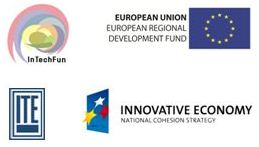Web-site: http://www.ite.waw.pl/intechfun/
Programme: Operational Program Innovative Economy, National Cohesion Strategy
Project co-ordinator: Institute of Electron Technology, Warsaw
Starting date: 01.09.2008
Duration: 64 months
Participants: Institute of Electron Technology
Institute of Physics Polish Academy of Sciences
Warsaw University of Technology
Silesian University of Technology
Technical University of Lodz
Military University of Technology
Project aim
The project is aimed at the development of innovative technological processes and designs, and based on these, novel semiconductor devices making use of wide bandgap semiconductors – ZnO, group III-nitrides, and SiC. The research embraces the following main topics:
- doping of ZnO in p-type,
- epitaxial growth of GaN/AlGaN structures on Si substrates,
- fabrication of photonic crystals in GaN and ZnO,
- fabrication of metal/semiconductor contacts with specific electrical and optical properties (ohmic contacts, Schottky barriers, transparent contacts), suitable for high temperature operation,
- fabrication of semiconductor/dielectric with specific electrical properties (gate dielectric, surface passivation).
The research includes modeling studies and thorough characterization of materials and device structures. High level of R&D activities The leading group for this project, the Dept. of Micro- and Nanotechnology of Wide Bandgap Semiconductors (http://www.ite.waw.pl/en/Z03.php) has a broad experience in the process technologies and device architectures for optoelectronics and electronics. Relevant experience includes processing of III-V devices involving nanostructures for photonics, high frequency, high-power & high-temperature electronics, development of thermally stable ohmic contacts toGaN, surface passivation methods, TCOs, p-type ZnO.The team was involved in a number of externally funded research projects on both national and international levels. Relevant European projects (6th& 7th FP) include: TERAVISION, AGETHA, AMORE, DENIS, NANOPHOS, HYPHEN and MORGAN. The Department is teamed with the Laboratory of Low Temperature Physics at the Institute of Physics of Polish Academy of Sciences and is a part of National Network of Excellence”New Materials and Sensors for Optoelectronics, Information Technologies, Energy, and Medicine”. The processing laboratory is fully equipped for device fabrication by optical and DUV lithography, nanoimprint and laser lithography and ICP/RIE etching. The key facilities used in the project include thin film deposition systems (Leybold L-560 vacuum evaporation and Z-400, Z-550 DC/RF magnetron sputtering systems) and UHV unbalanced magnetron sputtering system Gamma 1000C from Surrey NanoSystems Ltd., PECVD deposition module (Oxford Instruments DP 100), high-resolution photolithography (Karl Suss MJB-21 double side and MJB-3 DUV mask aligners), nanoimprint lithography (Obducat Eitre3 system) laser lithography (DWL 66FS Heidelberg Instruments), thermal processing (AST SHS 100 RTP & conventional furnaces), wet and dry chemical processing (Oxford Instruments PlasmaLab System 100ICP180), facilities for electrical, structural and optical characterisation (including Philips X-ray diffractometer and Tencor Thin Film Stress measurement system). The team has access to the extensive facilities for structural characterisation such as SIMS (Cameca IMS 6f), RBS (3SDH-2 Pelletron accelerator), advanced x-ray analysis, Variable Angle Spectroscopic Ellipsometry (VASE), AFM, SEM. Project results Process technologies were integrated into technological modules and their effectiveness validated in the specific electronic and photonic devices, and sensors. The demonstrators include:
- AlGaN/GaN HEMTs on Si substrate,
- SiC MESFETs and MOSFETs,
- GaN-based 385 nm LEDs,
- optical gas sensors based on ZnO and GaN.
The expected impact of the project will be establishing of interdisciplinary R&D platform capable to perform creative work, both within the project duration and in long-term timescale (minimum 5 years after the end of the project).

|